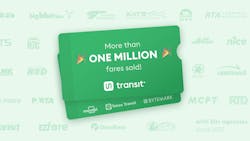Transit sells its millionth fare with agency and ticketing partners
A new milestone has been reached by Transit: Riders have used the app to make one million fare purchases, including passes used for trips with more than 50 partner transit agencies across the U.S. and Canada.
During the pandemic, transit agencies and riders alike embraced mobile ticketing as a way to encourage contactless payments. Since then, it’s become a must-have for any agency wanting to improve the passenger experience and encourage ridership recovery. Now, the number of fares sold through Transit is more than 300 percent higher than before the pandemic.
The rise in Transit mobile ticketing is also significantly outpacing ridership growth, as fare transactions in Transit have nearly doubled since the start of 2021. In comparison, U.S. stats from Transit’s APTA Ridership Trends dashboard estimate a 31 percent increase in trips since the start of this year.
“Transit is built by transit riders, for transit riders. We know firsthand that the best fare payment experience is almost invisible—without the hassle of multiple downloads and multiple logins,” said David Block-Schachter, chief business officer at Transit. “Mobile ticketing was an indispensable tool for transit agencies during the pandemic. Now the numbers we’re seeing make it clear. As riders return, they want everything they need in one place, so they can focus on what really matters: getting where they need to go.”
For transit agencies such as the Greater Dayton Regional Transit Authority (RT) in Ohio, mobile payments have become a staple for riders, with more than 30 percent of trips paid for with Transit and cash transactions reduced from 43 percent to 10 percent of boardings.
“Since first launching mobile ticketing in June 2020, our customers were quick to jump on board as many were already using Transit to plan their trips,” said Brandon Policicchio, chief customer and business development office, Greater Dayton RTA. “Now that fare capping is available, we can provide our customers the lowest possible fare every day, and greater fare equity than our previous payment system.”
Since Transit launched its first fare payment integration in April 2019, the number of riders using the app to pay for trips has grown to more than 130,000 across North America. Over this period, Transit has expanded its mobile ticketing functionality to integrate offerings from Masabi, Token Transit and Bytemark, three fare payments companies working with transit operators of all sizes.
Along with Transit, these companies and transit agencies are taking an open approach to Mobility-as-a-Service (MaaS), integrating fare payment and trip planning into one platform.
“As Transit’s mobile ticketing launch partner, we are today live with more than 27 agencies across North America, delivering a best-of-breed experience which increases the discoverability, accessibility and convenience of public transit,” said Brian Zanghi, CEO, Masabi. “From launching mobile ticketing in cities including Denver and Las Vegas to enabling multi-state regional initiatives with NEORide’s EZfare, Account-Based Ticketing for RTS in Rochester and Greater Dayton Regional Transit Authority, and delivering, stored value accounts, cash digitization options at retailers, transit centers and at Ticket Vending Machines nationwide, Masabi consistently leads the market and is excited for the next chapter in our partnership with Transit.”
Because Transit integrates multiple MaaS data sources together in a single account and app experience, riders can pay all types of fares using a familiar, unified app interface. This integrated approach also enables riders to plan a multimodal trip, track their ride in real time and make connections to on-demand microtransit, bikeshare, shared scooters, carshare and more. Fare payment is accessible directly from Transit’s home screen, with a prominent Buy Ticket button next to the agency’s logo as riders look up arrival times for buses and trains.
With just a few taps, riders can create a Transit account, pay their fare and board using either visual validation or barcode validators. In multiple markets, Transit also allows users to add value to smartcards, benefit from fare capping, and load cash to the app at fare vending machines or retail locations, which gives riders the benefits of mobile ticketing without needing access to a credit card.
